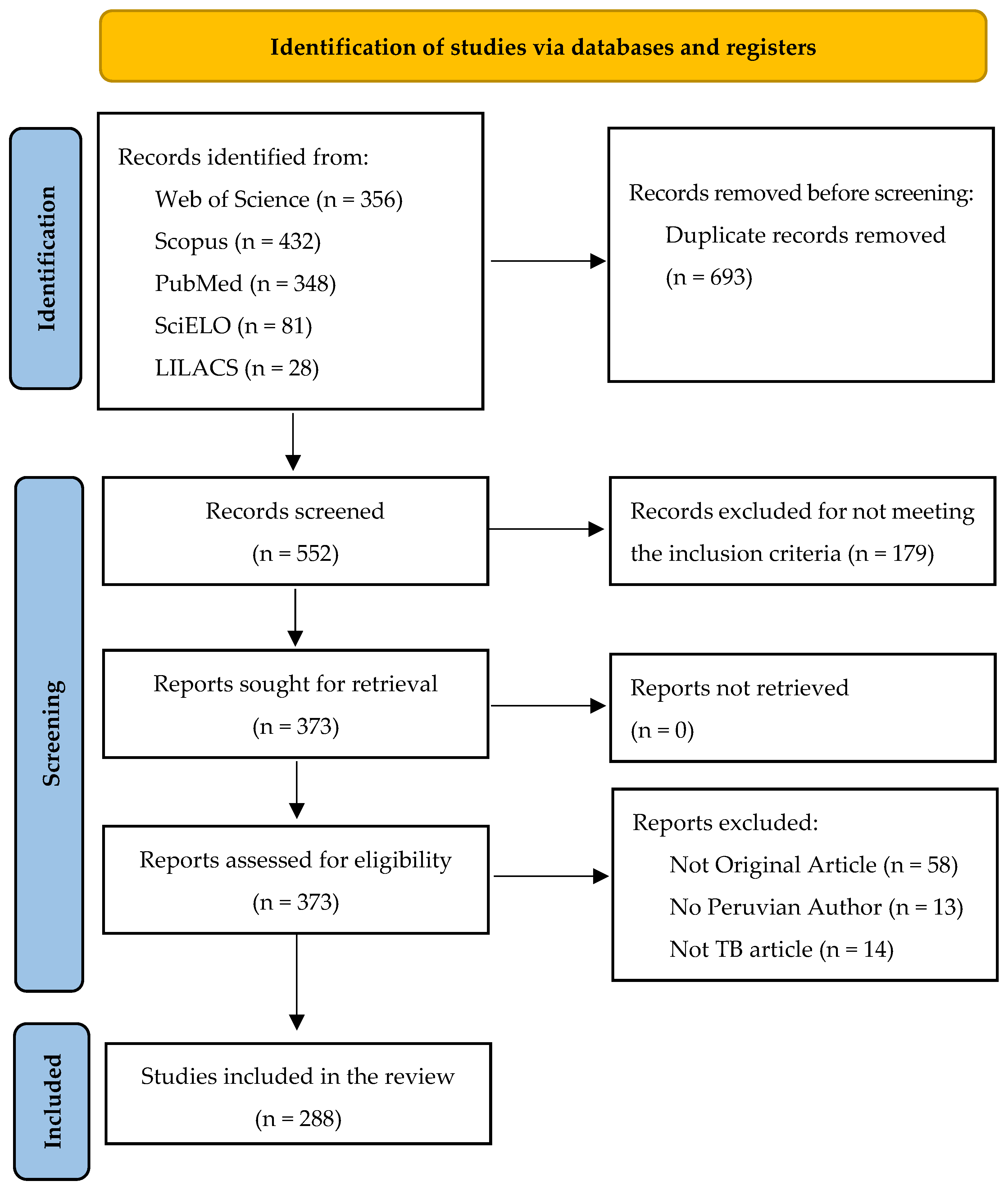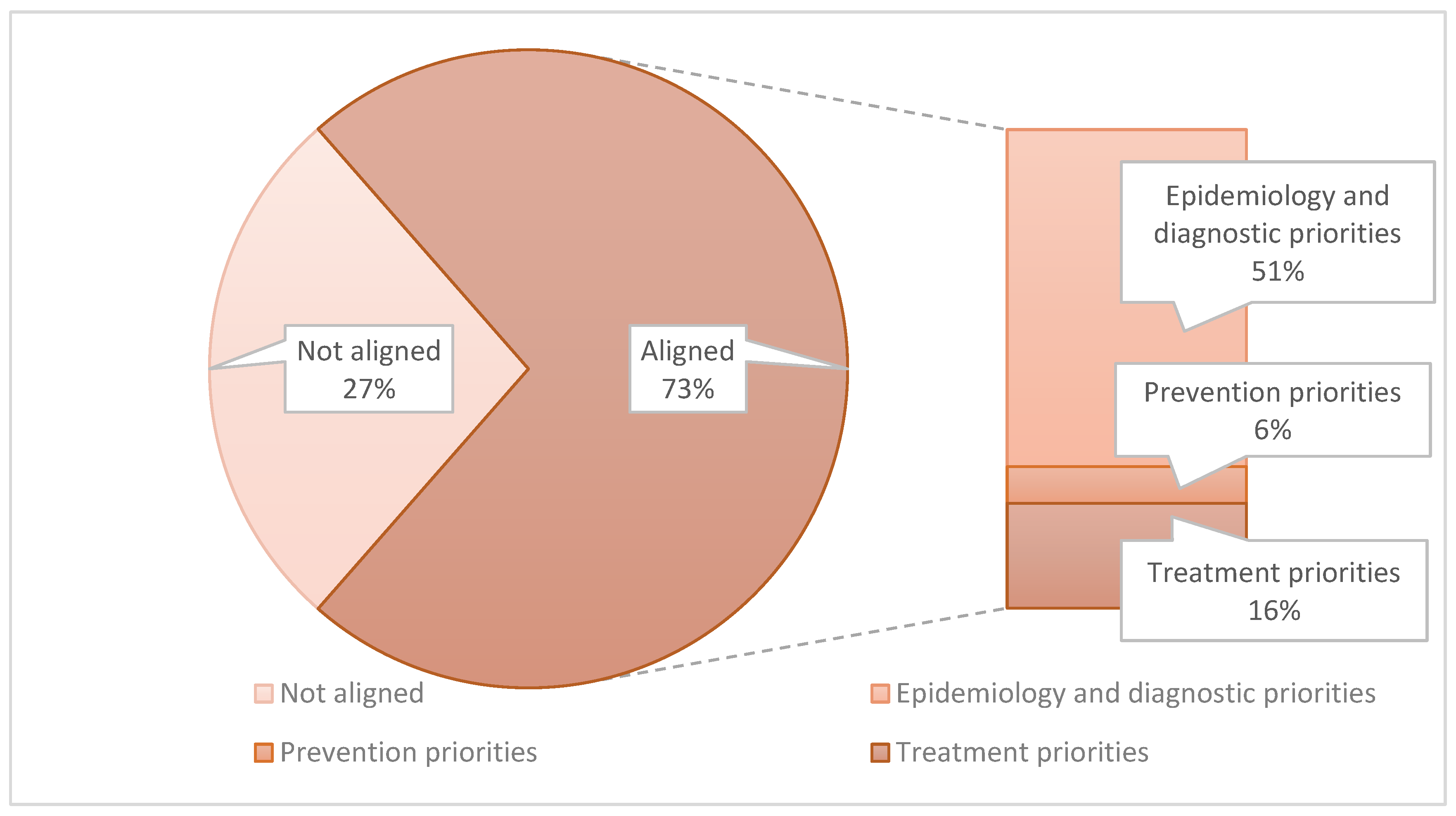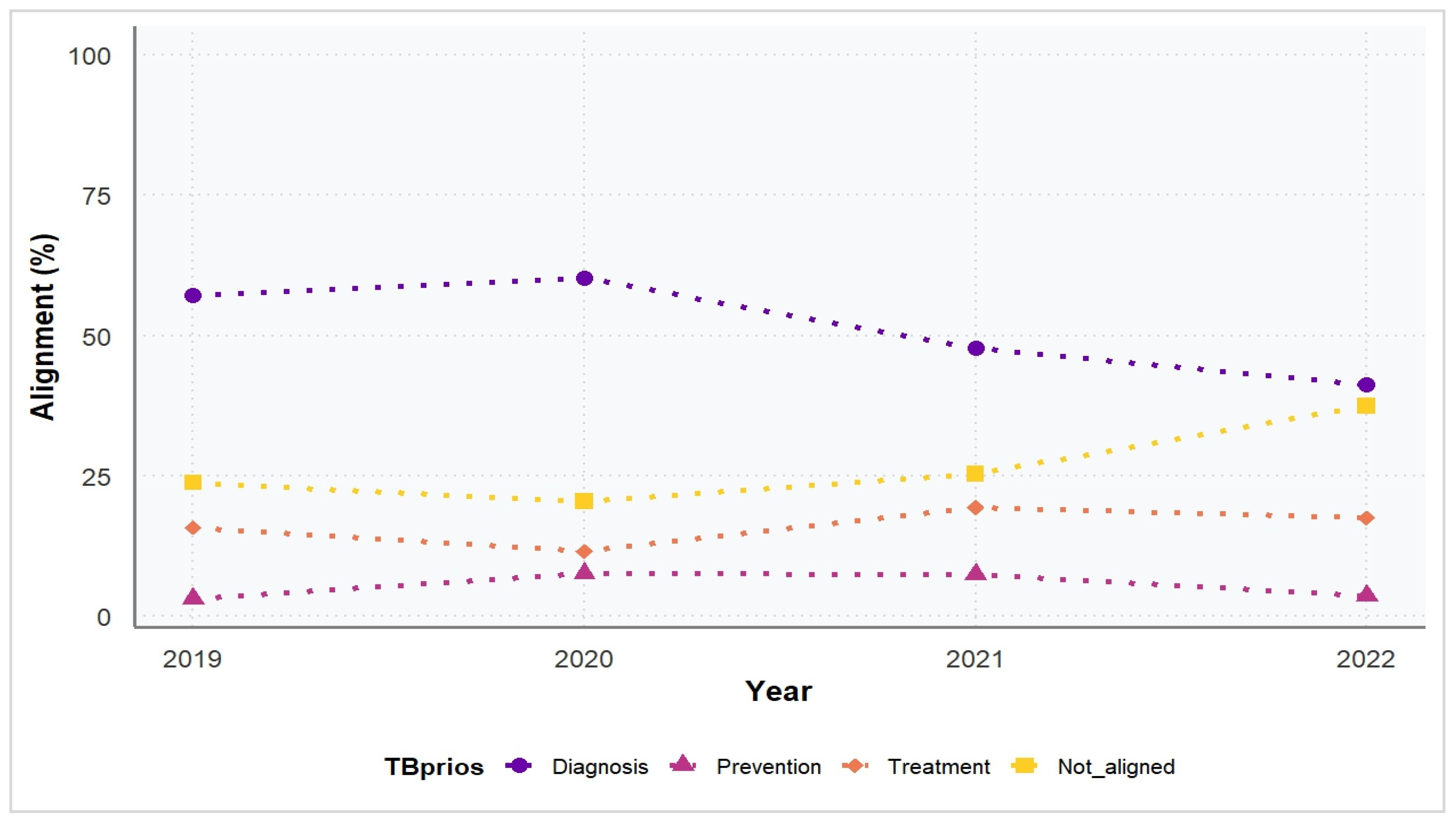Is Tuberculosis Scientific Research Aligned with National Research Priorities? A Bibliometric Analysis of Peruvian Scientific Production
Abstract
1. Introduction
2. Materials and Methods
2.1. Study Design and Search Strategy
2.2. Selection Criteria
2.3. Procedures
2.4. Variables and Data Extraction
2.5. Statistical Analysis
2.6. Ethics Statement
3. Results
4. Discussion
5. Conclusions
Supplementary Materials
Author Contributions
Funding
Data Availability Statement
Conflicts of Interest
Abbreviations
| WHO | World Health Organization |
| CI | Confidence interval |
| TB | Tuberculosis |
| TBprios | Peruvian National Tuberculosis Research Priorities |
References
- Alarcón, V., Alarcón, E., Figueroa, C., & Mendoza-Ticona, A. (2017). Tuberculosis en el Perú: Situación epidemiológica, avances y desafíos para su control. Revista Peruana de Medicina Experimental y Salud Publica, 34(2), 299–310. [Google Scholar] [CrossRef]
- Asubiaro, T., Onaolapo, S., & Mills, D. (2024). Regional disparities in Web of Science and Scopus journal coverage. Scientometrics, 129(3), 1469–1491. [Google Scholar] [CrossRef]
- Álvarez-Bornstein, B., Morillo, F., & Bordons, M. (2017). Funding acknowledgments in the Web of Science: Completeness and accuracy of collected data. Scientometrics, 112(3), 1793–1812. [Google Scholar] [CrossRef]
- Boudarene, L., James, R., Coker, R., & Khan, M. S. (2017). Are scientific research outputs aligned with national policy makers’ priorities? A case study of tuberculosis in Cambodia. Health Policy and Planning, 32(Suppl. S2), ii3–ii11. [Google Scholar] [CrossRef] [PubMed]
- Chalmers, I., Bracken, M. B., Djulbegovic, B., Garattini, S., Grant, J., Gülmezoglu, A. M., Howells, D. W., Ioannidis, J. P. A., & Oliver, S. (2014). How to increase value and reduce waste when research priorities are set. The Lancet, 383(9912), 156–165. [Google Scholar] [CrossRef]
- Di Gennaro, F., Lattanzio, R., Guido, G., Ricciardi, A., Novara, R., Patti, G., Cotugno, S., De Vita, E., Brindicci, G., Mariani, M. F., Ronga, L., Santoro, C. R., Romanelli, F., Stolfa, S., Papagni, R., Bavaro, D. F., De Iaco, G., & Saracino, A. (2022). Predictors for pulmonary tuberculosis outcome and adverse events in an Italian referral hospital: A nine-year retrospective study (2013–2021). Annals of Global Health, 88(1), 26. [Google Scholar] [CrossRef]
- Di Gennaro, F., Pizzol, D., Cebola, B., Stubbs, B., Monno, L., Saracino, A., Luchini, C., Solmi, M., Segafredo, G., Putoto, G., & Veronese, N. (2017). Social determinants of therapy failure and multi drug resistance among people with tuberculosis: A review. Tuberculosis, 103, 44–51. [Google Scholar] [CrossRef]
- Ekenoğlu Merdan, Y., & Etiz, P. (2022). A scopus-based bibliometric analysis of global tuberculosis publications: 1849–2020. Turk Toraks Dergisi (Turkish Thoracic Journal), 23(3), 246–256. [Google Scholar] [CrossRef]
- Garcia-Solorzano, F. O., De la Cruz Anticona, S. M., Pezua-Espinoza, M., Chuquispuma Jesus, F. A., Sanabria-Pinilla, K. D., Chavez Veliz, C., Huayta-Alarcón, V. A., Mayta-Tristan, P., & Lecca, L. (2025). Analyzing the drivers behind retractions in tuberculosis research. Publications, 13(1), 4. [Google Scholar] [CrossRef]
- Gebreselassie, N., Falzon, D., Zignol, M., & Kasaeva, T. (2019). Tuberculosis research questions identified through the WHO policy guideline development process. European Respiratory Journal, 53(3), 1802407. [Google Scholar] [CrossRef]
- Glänzel, W., & Schubert, A. (2005). Analysing scientific networks through co-authorship. In H. F. Moed, W. Glänzel, & U. Schmoch (Eds.), Handbook of quantitative science and technology research: The use of publication and patent statistics in studies of S&T systems (pp. 257–276). Springer Netherlands. [Google Scholar] [CrossRef]
- Instituto Nacional de Salud del Perú. (2024). Prioridades nacionales de investigación en salud. [Internet]. Available online: https://www.gob.pe/38070-prioridades-nacionales-de-investigacion-en-salud (accessed on 22 September 2025).
- Kumar, A., Koley, M., Yegros, A., & Rafols, I. (2024). Priorities of health research in India: Evidence of misalignment between research outputs and disease burden. Scientometrics, 129(3), 2433–2450. [Google Scholar] [CrossRef]
- Lestari, T., Fuady, A., Yani, F. F., Putra, I., Pradipta, I. S., Chaidir, L., Handayani, D., Fitriangga, A., Loprang, M. R., Pambudi, I., Ruslami, R., & Probandari, A. (2023). The development of the national tuberculosis research priority in Indonesia: A comprehensive mixed-method approach. PLoS ONE, 18(2), e0281591. [Google Scholar] [CrossRef] [PubMed]
- Liu, W. (2020). Accuracy of funding information in Scopus: A comparative case study. Scientometrics, 124(2), 803–811. [Google Scholar] [CrossRef]
- Liu, W., & Wang, H. (2025). Red alert: Millions of “homeless” publications in Scopus should be resettled. Journal of the Association for Information Science and Technology, 76(10), 1283–1291. [Google Scholar] [CrossRef]
- McGregor, S., Henderson, K. J., & Kaldor, J. M. (2014). How are health research priorities set in low and middle income countries? A systematic review of published reports. PLoS ONE, 9(10), e108787. [Google Scholar] [CrossRef]
- Ministerio de Salud. (2020). Decreto legislativo N.° 1504. [Internet]. Available online: https://www.gob.pe/institucion/presidencia/normas-legales/576178-1504 (accessed on 22 September 2025).
- Ministerio de Salud del Perú. (2018). Resolución ministerial N.° 591-2018/MINSA. [Internet]. Available online: https://www.gob.pe/institucion/minsa/normas-legales/1462-591-2018-minsa (accessed on 22 September 2025).
- Ministerio de Salud del Perú. (2022). Resolución ministerial N.° 729-2022-MINSA. [Internet]. Available online: https://www.gob.pe/institucion/minsa/normas-legales/3495599-729-2022-minsa (accessed on 22 September 2025).
- Ministerio de Salud del Perú. (2024). Resolución ministerial N.° 184-2024-MINSA. [Internet]. Available online: https://www.gob.pe/institucion/minsa/normas-legales/5364816-184-2024-minsa (accessed on 22 September 2025).
- Morán-Mariños, C., Visconti-Lopez, F. J., Espiche, C., Llanos-Tejada, F., Villanueva-Villegas, R., Casanova-Mendoza, R., & Bernal-Turpo, C. (2024). Research priorities and trends in pulmonary tuberculosis in Latin America: A bibliometric analysis. Heliyon, 10(15), e34828. [Google Scholar] [CrossRef]
- Nishida, L., & Teixeira, M. d. O. (2022). Encaixando agendas: Análise dos efeitos da agenda nacional de pesquisa em saúde em laboratórios de pesquisa biomédica. Revista Tecnologia e Sociedade, 18(52), 52. [Google Scholar] [CrossRef]
- Reveiz, L., Elias, V., Terry, R. F., Alger, J., & Becerra-Posada, F. (2013). Comparison of national health research priority-setting methods and characteristics in Latin America and the Caribbean, 2002–2012. Revista Panamericana De Salud Publica = Pan American Journal of Public Health, 34(1), 1–13. [Google Scholar]
- Romani Romani, F. R., Roque Henríquez, J., Vásquez Loarte, T., Mormontoy Calvo, H., & Vásquez Soplopuco, H. (2016). Análisis bibliométrico de la producción científica sobre las agendas nacionales de investigación en el Perú 2011–2014. Anales de La Facultad de Medicina, 77(3), 241–249. [Google Scholar] [CrossRef]
- Rudan, I., Gibson, J. L., Ameratunga, S., El Arifeen, S., Bhutta, Z. A., Black, M., Black, R. E., Brown, K. H., Campbell, H., Carneiro, I., Chan, K. Y., Chandramohan, D., Chopra, M., Cousens, S., Darmstadt, G. L., Meeks Gardner, J., Hess, S. Y., Hyder, A. A., Kapiriri, L., … Child Health and Nutrition Research Initiative. (2008). Setting priorities in global child health research investments: Guidelines for implementation of CHNRI method. Croatian Medical Journal, 49(6), 720–733. [Google Scholar] [CrossRef]
- Savchenko, I., & Kosyakov, D. (2022). Lost in affiliation: Apatride publications in international databases. Scientometrics, 127(6), 3471–3487. [Google Scholar] [CrossRef]
- Sousa Vieira, E., & Cerdeira, J. (2025). Research on neonatal conditions in Africa: Funding activities from a bibliometric perspective. Publications, 13(2), 26. [Google Scholar] [CrossRef]
- Sugimoto, A., Krull, S., Nomura, S., Morita, T., & Tsubokura, M. (2012). The voice of the most vulnerable: Lessons from the nuclear crisis in Fukushima, Japan. Bulletin of the World Health Organization, 90(8), 629–630. [Google Scholar] [CrossRef]
- The JAMA Forum. (2025). Cutting the NIH—The $8 trillion health care catastrophe. JAMA Health Forum. Available online: https://jamanetwork.com/journals/jama-health-forum/fullarticle/2834949 (accessed on 22 September 2025).
- Thelwall, M., Simrick, S., Viney, I., & Oancea, A. (2023). What is research funding, how does it influence research, and how is it recorded? Key dimensions of variation. Scientometrics, 128(11), 6085–6106. [Google Scholar] [CrossRef]
- Torres-Pascual, C., Sánchez-Pérez, H. J., & Àvila-Castells, P. (2021). Geographical distribution and international collaboration of Latin American and Caribbean scientific publications on tuberculosis in Pubmed. Revista Peruana de Medicina Experimental y Salud Pública, 38(1), 49–57. [Google Scholar] [CrossRef]
- Veretennik, E., & Yudkevich, M. (2023). Inconsistent quality signals: Evidence from the regional journals. Scientometrics, 128(6), 3675–3701. [Google Scholar] [CrossRef] [PubMed]
- Wang, Q., Fu, H., Zhang, Y., Zhang, M., Xu, J., & Fu, J. (2025). Bibliometric and visualization analysis of DprE1 inhibitors to combat tuberculosis. Drug Design, Development and Therapy, 19, 2577–2596. [Google Scholar] [CrossRef] [PubMed]
- World Health Organization. (2015). The end TB strategy. [Internet]. Available online: https://www.who.int/teams/global-programme-on-tuberculosis-and-lung-health/the-end-tb-strategy (accessed on 22 September 2025).
- World Health Organization. (2020). A systematic approach for undertaking a research priority-setting exercise: Guidance for WHO staff. World Health Organization. Available online: https://iris.who.int/handle/10665/334408 (accessed on 22 September 2025).
- World Health Organization. (2023). Global tuberculosis report 2024. World Health Organization. Available online: https://www.who.int/teams/global-programme-on-tuberculosis-and-lung-health/tb-reports/global-tuberculosis-report-2024/tb-disease-burden/1-3-drug-resistant-tb (accessed on 22 September 2025).



| Web of Science |
| TS = (tuberculosis OR TB OR “Mycobacterium tuberculosis” OR “Koch disease” OR tuberculoses) AND CU = (Peru) AND PY = (2019–2022) |
| Scopus |
| TITLE-ABS-KEY (“tuberculosis” OR “Mycobacterium tuberculosis” OR “Koch disease” OR “tuberculoses” OR “TB” OR “Koch’s Disease” OR “Kochs Disease”) AND AFFILCOUNTRY (Peru) AND (PUBYEAR > 2018 AND PUBYEAR < 2023) |
| PubMed |
| (tuberculosis[mh] OR tuberculosis[tiab] OR TB[tiab] OR tuberculoses [tiab] OR “Koch disease”[tiab] OR Tuberculoses[tiab] OR “Kochs Disease”[tiab] OR “Koch’s Disease”[tiab]) AND (Peru*[ad]) AND 2019:2022 [dp] |
| SciELO |
| Expressão: (ti:(tuberculosis OR “mycobacterium tuberculosis” OR “bacilo de koch”)) OR (ab:(tuberculosis OR “mycobacterium tuberculosis” OR “bacilo de koch”)) Filtros aplicados: (Ano de publicação: 2021) (Ano de publicação: 2022) (Ano de publicação: 2020) (Ano de publicação: 2019) |
| LILACS |
| tw:(tuberculosis OR tb OR “mycobacterium tuberculosis” OR tuberculoses OR “Koch disease” OR tuberculose OR “bastão de koch” OR “bacilo de koch”) AND afp:(peru) AND (year_cluster:[2019 TO 2022]) AND (db:(“LILACS”)) |
| Type of TBprios | National Funding | International Funding | International and National Funding | Self- Funding | Not Reported |
|---|---|---|---|---|---|
| Diagnostic priorities (n = 148, 100%) | 18 (12.0%) | 86 (57.3%) | 12 (8.0%) | 16 (10.7%) | 18 (12.0%) |
| Prevention priorities (n = 16, 100%) | 1 (6.3%) | 11 (68.8%) | 1 (6.3%) | 1 (6.3%) | 2 (12.3%) |
| Treatment priorities (n = 46, 100%) | 4 (8.7%) | 18 (39.1%) | 3 (6.5%) | 13 (28.3%) | 8 (17.4%) |
| Not aligned (n = 78, 100%) | 9 (11.5%) | 36 (46.2%) | 5 (6.4%) | 16 (20.5%) | 12 (15.4%) |
| Type of TBprios | International Collaboration | Q1 | Q2 | Q3 | Q4 | Non- Quartile | Citations * |
|---|---|---|---|---|---|---|---|
| Diagnostic priorities (n = 148, 100%) | 110 (74.3%) | 79 (53.4%) | 31 (21.0%) | 17 (11.5%) | 12 (8.1%) | 9 (6.1%) | 4 (1–12) |
| Prevention priorities (n = 16, 100%) | 15 (93.7%) | 9 (56.3%) | 6 (37.5%) | 1 (6.3%) | 0 (0.0%) | 0 (0.0%) | 5.5 (2.5–15.5) |
| Treatment priorities (n = 46, 100%) | 30 (65.2%) | 21 (45.7%) | 4 (8.7%) | 1 (2.2%) | 13 (28.3%) | 7 (15.2%) | 2.5 (0–8) |
| Not aligned (n = 78, 100%) | 60 (76.9%) | 38 (48.7%) | 22 (28.2%) | 8 (10.3%) | 5 (6.4%) | 5 (6.4%) | 3.5 (1–8) |
| Total (n = 288, 100%) | 215 (74.7%) | 147 (51.0%) | 63 (21.9%) | 27 (9.4%) | 30 (10.4%) | 21 (7.3%) | 4 (1–11) |
Disclaimer/Publisher’s Note: The statements, opinions and data contained in all publications are solely those of the individual author(s) and contributor(s) and not of MDPI and/or the editor(s). MDPI and/or the editor(s) disclaim responsibility for any injury to people or property resulting from any ideas, methods, instructions or products referred to in the content. |
© 2025 by the authors. Licensee MDPI, Basel, Switzerland. This article is an open access article distributed under the terms and conditions of the Creative Commons Attribution (CC BY) license (https://creativecommons.org/licenses/by/4.0/).
Share and Cite
Garcia-Solorzano, F.O.; Angulo-Bazán, Y.; Soriano-Martinez, S.; Farfan-Zapata, O.; Lecca, L. Is Tuberculosis Scientific Research Aligned with National Research Priorities? A Bibliometric Analysis of Peruvian Scientific Production. Publications 2025, 13, 47. https://doi.org/10.3390/publications13040047
Garcia-Solorzano FO, Angulo-Bazán Y, Soriano-Martinez S, Farfan-Zapata O, Lecca L. Is Tuberculosis Scientific Research Aligned with National Research Priorities? A Bibliometric Analysis of Peruvian Scientific Production. Publications. 2025; 13(4):47. https://doi.org/10.3390/publications13040047
Chicago/Turabian StyleGarcia-Solorzano, Franko O., Yolanda Angulo-Bazán, Sofia Soriano-Martinez, Olenka Farfan-Zapata, and Leonid Lecca. 2025. "Is Tuberculosis Scientific Research Aligned with National Research Priorities? A Bibliometric Analysis of Peruvian Scientific Production" Publications 13, no. 4: 47. https://doi.org/10.3390/publications13040047
APA StyleGarcia-Solorzano, F. O., Angulo-Bazán, Y., Soriano-Martinez, S., Farfan-Zapata, O., & Lecca, L. (2025). Is Tuberculosis Scientific Research Aligned with National Research Priorities? A Bibliometric Analysis of Peruvian Scientific Production. Publications, 13(4), 47. https://doi.org/10.3390/publications13040047






